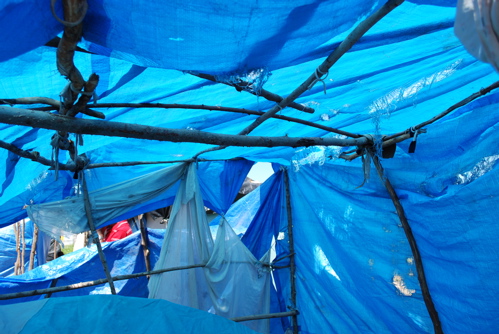Haiti's Potemkin village, the Camp Corail-Cesselesse relocation camp, is not safe. With the approach of Tomas, which is morphing daily from tropical storm to hurricane and back again, Haitian officials are urging the 7,850 residents of its flagship camp to evacuate and "find different locations." For those who don't know the story, Grigori Aleksandrovich Potemkin, commander-in-chief of the Russian army in the late eighteenth century, was also the lover of Catherine the Great. Potemkin had elaborate fake villages constructed for her tours of the Ukraine and the Crimea.
The government of Haiti has no less of a love affair with foreign aid.
The rainy season peaks in October and continues through November. Erected on a desolate plain that is subject to flooding when rains come and water pours down the ravines of Mon Cabrit, or Goat Mountain, "Camp Corail" is Haiti's grand illusion, and the curtain is about to be ripped aside. Hopefully, US taxpayers and donors will take note that this cooperative venture between the Haitian government and USAID's implementing partners has been a dismal failure. Heavy rains are a way of life for Haitians, but why the Haitian government green-lighted a relocation camp in a flood zone is anyone's guess. Even if Tomas retains its current incarnation as a depression, flooding is inevitable.
In May we looked closely at the camp, discovered that the tents would not stay dry even in the smallest rainstorms, and that the people were hungry, feeling abandoned, tricked and dispossessed. No matter how white the tents, no matter how orderly the rows of stifling white nylon, Corail was nothing more than a pretty white party dress, designed to distract from the reality of life in the camps.
 Camp Corail in May
Camp Corail in May
Here is some of their testimony from Corail, taken in May.
"We don't know what will happen."
"We need food, people are waiting for work."
"There is not enough light at night."
"There are stones under the tents, no mattresses, and we cannot sleep."
"I have back pain because of the stones."
"The stones put holes in the tent floors and water gets in and pushes up the tent."
"The tents shake in the wind and the stakes pull out of the ground."
"Last night we had a 6.7 wind." (comparing the wind to an earthquake)
These tents are supposed to be hurricane proof and the resident was using the metaphor of an earthquake to demonstrate how vulnerable residents felt in a thunderstorm.
"We pass out in the heat."
"They just forced us to move from Petionville camp."
"When our President Preval came to visit with VIPS he looked so weak he needed help to walk."
It is not news that Corail-Cesselesse is not safe, but it should be news that there are at least 1.5 million victims of the January 2010 earthquake that killed upwards of 300,000 still living under tarps in other camps.
 Wide shot of Camp Obama/Canaan
Wide shot of Camp Obama/Canaan
In fact, in May we looked just over the valley and saw over 5,000 residents of "Camp Obama" were still living under blue tarps and shreds of flapping clear white plastic that were more suitable for shopping bags than shelter. We had visited with them in March and not much had changed except the name. Leaders told us they had changed the camp name to "Obama" from "Canaan" in hope that they would get some help. It had not been forthcoming. Let's re-brand living conditions in Haiti and describe them accurately. The tent cities are really tarp cities and should be described as such. The media re-branded the BP oil "spill" as a "catastrophe" and a "disaster," and we can do the same for the Haitian tarp dwellers.

The recent cholera outbreak has added a new fear to the equation as health workers struggle to contain it.
1.5 million people have nowhere to go. Please examine the OCHA (United Nations) spreadsheet on relocation shelters. Do the math. Maybe, just maybe, the shelters can handle 50,000. 1.5-1.7 million are in the tarp cities. Millions more are still in their homes on hillsides vulnerable to flooding and landslides.
To suggest that they have options is ludicrous, but that is exactly what the press is doing.
We will be back in Haiti on Saturday and hope this time to use photos, each representing a thousand useless words, or more.
Photos by G. Nienaber and copyright removed in Haiti's interest.
For further reports on Camp Canaan and Camp Corail, check out Mac McKinney's photo-essays from May 2010 on each:
